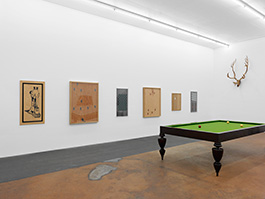
| français I english |
| Collections / October 12, 2016— |
|
Sherrie Levine |
In the early 1980s, many figures in New York’s art scene adopted quotation and appropriation as their favourite means of expression. One of them was Sherrie Levine. She copied or reproduced emblematic works of modernity in order to question and test its underlying aesthetic categories, such as authorship or originality. Artists of this generation (Barbara Kruger, Richard Prince, Haim Steinbach, Cindy Sherman, Jenny Holzer, Richard Pettibone, Allan McCollum) combat the restoration of the romantic notions of art of a now deemed obsolete metaphysics. Several women took part in this adventure, claiming a place for themselves in an art history dominated by men, and in particular denouncing “the art world [as] an arena for the celebration of male desire.” Levine is involved in a paradigm shift: the object of criticism was no longer the museum, as it had been in the 1970s with the work of Daniel Buren, Michael Asher or Marcel Broodthaers. Instead, criticism now focused on ideological discourses that sought to pervade and dominate the whole of society—especially outside museums, for instance in the mass media. In response to the writings of Roland Barthes and Michel Foucault, Levine’s work was initially seen as a death certificate for the author/artist. Such interpretations were qualified by the later development of her work, suggesting that the notion of the author is foremost a historical construction. Rather than rejecting this notion and concluding that it no longer exists, she attempts to redefine it. “We do believe,” says Levine, “that there are such things as authorship and owner- ship. But I think at different times we interpret these words differently. It’s the dialectical nature of these terms that now interests me.” This is also what to make of Levine’s titles—After Piet Mondrian, After Kazimir Malevich, After Marcel Duchamp, After Egon Schiele. But what golden age do all these “afters” refer to, if not triumphant modernity? Her work is a manifest expression of the impossibility of mourning for the values of modernity. Hence her melancholy, hence her nostalgia for a history of constantly moving on, of successive breaks with the past, orchestrated by avant-gardes on the tabula rasa principle. Sherrie Levine undoubtedly subscribes to Theodor Adorno’s view that the happiness promised by adventure—that of the historic early twentieth-century avant-gardes—never materialised. Her art is post-catastrophe—some might say post-Auschwitz and post-Hiroshima—but also post-failure of the avant-garde. Her work records this state of affairs, and finally puts this failure in its proper perspective without being able to find a suitable counterpart for this loss. Sherrie Levine’s work can thus be seen as a monument to the glory of dashed hopes. Lionel Alèze |
|
|
 |
|
View of the exhibition, MAMCO, 2016. |